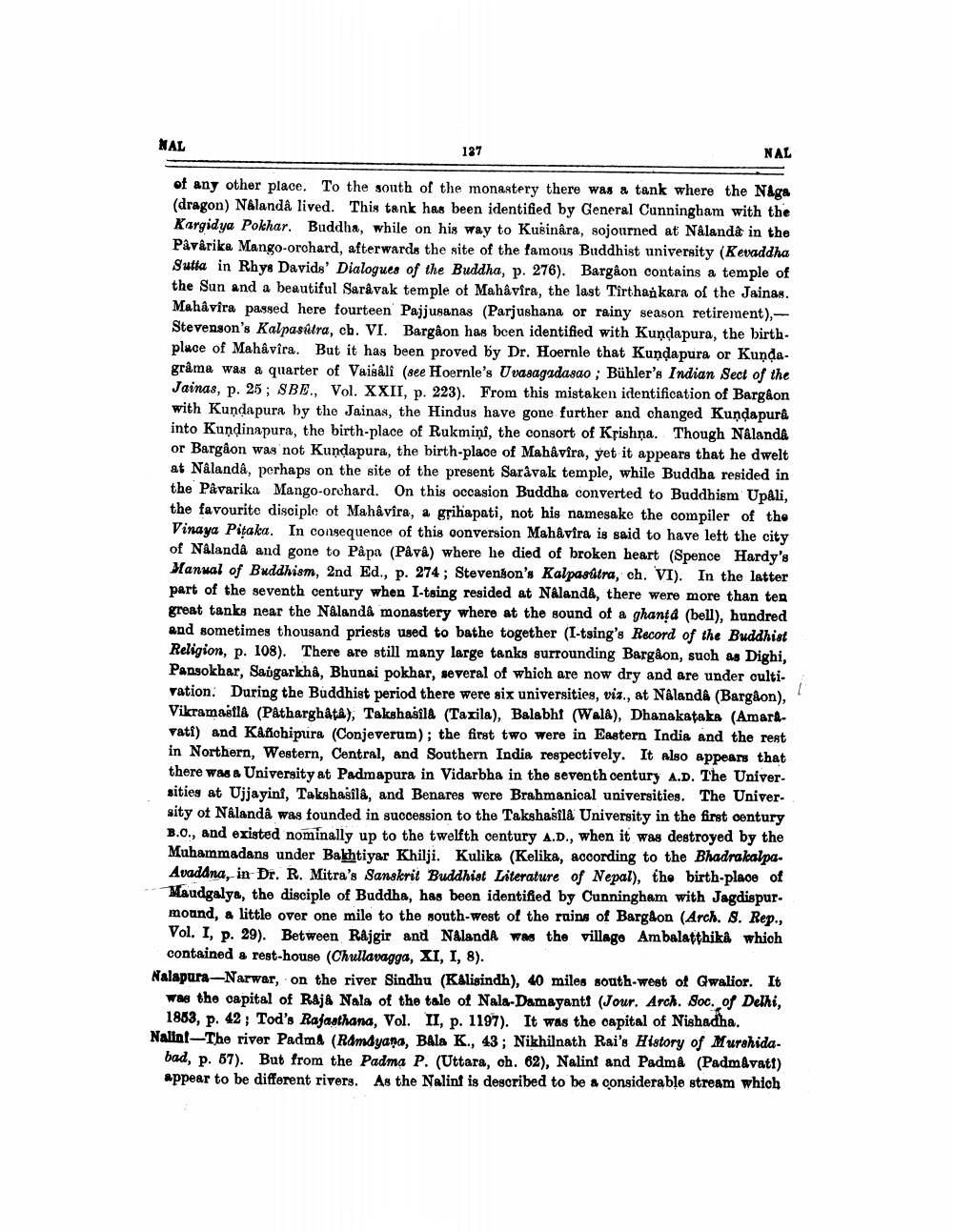________________
NAL
127
NAL
of any other place. To the south of the monastery there was a tank where the Någa (dragon) Nalandâ lived. This tank has been identified by General Cunningham with the Kargidya Pokhar. Buddha, while on his way to Kusinâra, sojourned at Nalanda in the Påvârika Mango-orohard, afterwards the site of the famous Buddhist university (Kevaddha Sutta in Rhye Davids' Dialogues of the Buddha, p. 276). Bargaon contains a temple of the Sun and a beautiful Sarâvak temple of Mahavira, the last Tirthankara of the Jainas. Mahavira passed here fourteen Pajjunanas (Parjushana or rainy season retirement), Stevenson's Kalpasútra, ch. VI. Bargaon has been identified with Kundapura, the birthplace of Mahavira. But it has been proved by Dr. Hoernle that Kundapura or Kundagrâma was a quarter of Vaisali (see Hoernle's Uvasagadasao ; Bühler's Indian Sect of the Jainas, p. 25; SBE., Vol. XXII, p. 223). From this mistaken identification of Bargaon with Kundapura by the Jainas, the Hindus have gone further and changed Kundapurê into Kundinapura, the birth-place of Rukmiņi, the consort of Krishna. Though NÅlanda or Bargaon was not Kundapura, the birth-place of Mahavira, yet it appears that he dwelt at Nålandâ, perhaps on the site of the present Saråvak temple, while Buddha resided in the Påvarika Mango-orchard. On this occasion Buddha converted to Buddhism Upali, the favourite disciple of Mahavira, a grihapati, not his namesake the compiler of the Vinaya Pitaka. In consequence of this conversion Mahavira is said to have left the city of Nalanda and gone to Påpa (Påva) where he died of broken heart (Spence Hardy's Manual of Buddhism, 2nd Ed., p. 274; Stevenson's Kalpasútra, ch. VI). In the latter part of the seventh century when I-tsing resided at Nalanda, there were more than ten great tanke near the Nalanda monastery where at the sound of a ghanta (bell), hundred and sometimes thousand priests used to bathe together (I-tsing's Record of the Buddhist Religion, p. 108). There are still many large tanks gurrounding Bargaon, such as Dighi, Pensokhar, Saigarkha, Bhunai pokhar, several of which are now dry and are under cultiration. During the Buddhist period there were six universities, viz., at Nalanda (Bargaon), Vikramasila (Patharghata), Takshasila (Taxila). Balabht (Walk), Dhanakataka (Amaravati) and Kanchipura (Conjeverum); the first two were in Eastern India and the rest in Northern, Western, Central, and Southern India respectively. It also appears that there was a University at Padmapura in Vidarbha in the seventh century A.D. The Universities at Ujjayini, Takshasila, and Benares were Brahmanical universities. The University of Nalandâ was founded in succession to the Takshasila University in the first century B.O., and existed nominally up to the twelfth century A.D., when it was destroyed by the Muhammadans under Bakhtiyar Khilji. Kulika (Kelika, according to the Bhadrakalpa. Avadana, in Dr. R. Mitra's Sanskrit Buddhist Literature of Nepal), the birth-place of Maudgalya, the disciple of Buddha, has been identified by Cunningham with Jagdispur. mound, a little over one mile to the south-west of the rains of Bargaon (Arch. 8. Rep., Vol. I, p. 29). Between Rajgir and NalandA was the village Ambalatthika which
contained a rest-house (Chullavagga, XI, I, 8). Nalapura-Narwar, on the river Sindhu (Kalisindh), 40 miles south-west of Gwalior. It
was the capital of Raja Nala of the tale of Nala-Damayanti (Jour. Arch. Soc. of Delhi,
1863, p. 42; Tod's Rajasthana, Vol. II, p. 1197). It was the capital of Nishadha. Nalint-The river Padma (Ramdyana, Bala K., 43; Nikhilnath Rai's History of Murshida
bad, p. 57). But from the Padma P. (Uttara, ch. 62), Nalint and Padmé (Padmavati) appear to be different rivers. As the Nalint is described to be a considerable stream which




